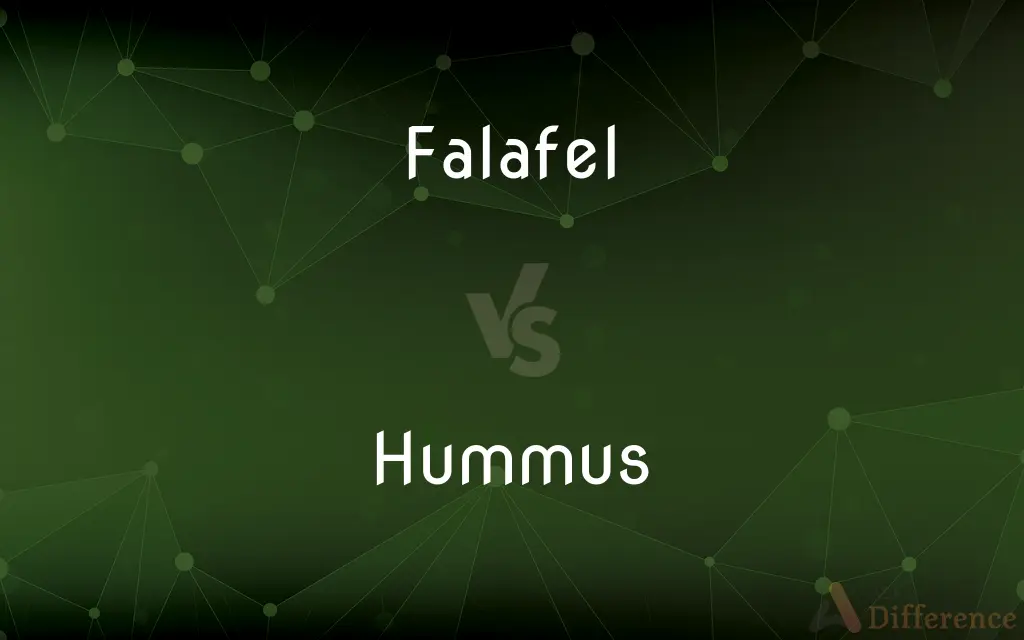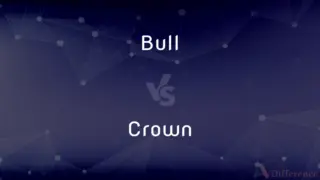Falafel vs. Hummus — What's the Difference?
By Tayyaba Rehman & Maham Liaqat — Updated on March 27, 2024
Falafel are deep-fried balls made from ground chickpeas or fava beans, while hummus is a smooth spread made from mashed chickpeas, tahini, olive oil, lemon juice, and garlic.

Difference Between Falafel and Hummus
Table of Contents
ADVERTISEMENT
Key Differences
Falafel, a Middle Eastern dish, consists of ground chickpeas or fava beans mixed with herbs and spices, then shaped into balls or patties and deep-fried to a golden brown. Hummus, also originating from the Middle East, is a creamy spread created by blending cooked chickpeas with tahini, olive oil, lemon juice, and garlic, resulting in a smooth and savory dip.
The primary ingredient in both falafel and hummus is chickpeas, which are valued for their protein content and versatility. However, the preparation and presentation of these dishes are markedly different, with falafel being cooked through deep-frying and served as a main dish or in sandwiches, whereas hummus is typically served as a dip or spread.
Falafel is often enjoyed as a street food or fast food in the Middle East, commonly wrapped in a pita bread with vegetables and tahini sauce. Hummus, on the other hand, is a staple in Middle Eastern cuisine, served as a side dish or appetizer with flatbread, vegetables, or as a condiment in various dishes.
The texture and flavor profiles of falafel and hummus also differ significantly. Falafel has a crispy exterior with a soft, herbaceous interior, while hummus offers a creamy, smooth consistency with a balance of nutty and tangy flavors.
Nutritionally, both dishes provide a good source of fiber and protein. Falafel, due to being deep-fried, is higher in calories and fat, while hummus, rich in healthy fats from olive oil and tahini, can be a part of a heart-healthy diet.
ADVERTISEMENT
Comparison Chart
Main Ingredient
Ground chickpeas or fava beans.
Mashed chickpeas.
Preparation
Mixed with herbs and spices, shaped into balls or patties, and deep-fried.
Blended with tahini, olive oil, lemon juice, and garlic into a smooth spread.
Serving
As a main dish, in sandwiches, or as street food.
As a dip, spread, or side dish with bread or vegetables.
Texture
Crispy exterior with a soft interior.
Creamy and smooth.
Flavor Profile
Herbaceous with a hint of spices.
Nutty, tangy, with a hint of garlic.
Nutrition
Higher in calories and fat due to deep-frying.
Rich in healthy fats, lower in calories compared to falafel.
Compare with Definitions
Falafel
Often served in a pita or flatbread with salads and sauces.
Street vendors offer falafel wrapped in pita with pickled vegetables and spicy sauce.
Hummus
A creamy spread made from mashed chickpeas, blended with tahini, olive oil, lemon juice, and garlic.
I served hummus as a dip with carrot sticks and cucumber slices for an appetizer.
Falafel
A Middle Eastern dish of spiced, ground chickpeas or fava beans, formed into balls or patties and deep-fried.
For lunch, I had a falafel sandwich filled with crispy balls, tomatoes, and tahini sauce.
Hummus
Characterized by its smooth texture and combination of tangy, nutty flavors.
The homemade hummus was exceptionally smooth and flavorful, with a perfect balance of lemon and tahini.
Falafel
Can be a part of various meals, from fast food to gourmet dishes.
Gourmet restaurants serve falafel with artisanal dips and side salads.
Hummus
A staple in Middle Eastern cuisine, often accompanied by flatbread.
At the family gathering, we enjoyed warm flatbread with fresh hummus.
Falafel
Known for its crispy texture and rich, herbaceous flavor.
The falafel had a perfect crispy crust with a soft, flavorful center.
Hummus
A versatile dish that can be used as a dip, spread, or ingredient in other recipes.
For dinner, I spread hummus on my chicken wrap for extra flavor and creaminess.
Falafel
Considered a protein-rich vegetarian option.
Falafel is a popular choice among vegetarians for its high protein content.
Hummus
Nutritious and rich in healthy fats, protein, and fiber.
As part of my diet, I include hummus for its health benefits and satisfying nature.
Falafel
Falafel (; Arabic: فلافل, [fæˈlæːfɪl] (listen)) is a deep-fried ball or patty-shaped fritter made from ground chickpeas, fava beans, or both. Falafel is a traditional Middle Eastern food, commonly served in a pita, which acts as a pocket, or wrapped in a flatbread known as taboon; "falafel" also frequently refers to a wrapped sandwich that is prepared in this way.
Hummus
Hummus (, ; Arabic: حُمُّص, 'chickpeas'; full Arabic name: ḥummuṣ bi-ṭ-ṭaḥīna Arabic: حمص بالطحينة, 'chickpeas with tahini') is a Middle Eastern dip, spread, or savory dish made from cooked, mashed chickpeas blended with tahini, lemon juice, and garlic. The standard garnish in the Middle East includes olive oil, a few whole chickpeas, parsley, and paprika.In Middle Eastern cuisine, it is usually eaten as a dip, with pita bread.
Falafel
A mixture of ground spiced chickpeas or fava beans that is shaped into balls and deep-fried.
Hummus
A smooth thick mixture of mashed chickpeas, tahini, oil, lemon juice, and garlic, used especially as a dip for pita.
Falafel
A fried ball made of such a mixture.
Hummus
A Levantine Arab dip made of chickpea paste with various additions, such as olive oil, fresh garlic, lemon juice, and tahini, often eaten with pitta bread, or as a meze.
Falafel
A sandwich filled with such balls.
Hummus
A thick spread made from mashed chickpeas, tahini, lemon juice and garlic; used especially as a dip for pita; originated in the Middle East
Falafel
(uncountable) A Middle Eastern food in the form of balls made from chickpeas or broad beans and other ingredients. Often served in a pita.
There's a stall at the market that sells fantastic falafel.
Falafel
(countable) A pita with falafel balls inside (like a sandwich or a wrap).
Falafel
(countable) A single falafel ball.
The stallholder puts salad into an open pita bread, followed by the four falafels, and then liberally covers them with hummus.
Falafel
Small croquette of mashed chick peas or fava beans seasoned with sesame seeds
Common Curiosities
What are the main ingredients in falafel and hummus?
Both falafel and hummus primarily use chickpeas, but falafel is deep-fried and often includes fava beans, herbs, and spices, while hummus is blended with tahini, olive oil, lemon juice, and garlic.
How do the textures of falafel and hummus compare?
Falafel has a crispy exterior and soft interior, whereas hummus is creamy and smooth
Can falafel and hummus be part of a healthy diet?
Yes, both are rich in protein and fiber. However, falafel is higher in calories due to deep-frying, while hummus contains healthy fats.
How are falafel and hummus traditionally served?
Falafel is typically served in sandwiches or as a main dish, while hummus is used as a dip or spread.
What cultural significance do falafel and hummus have in Middle Eastern cuisine?
Falafel and hummus are integral to Middle Eastern cuisine, reflecting the region's culinary traditions, with hummus often viewed as a symbol of hospitality and falafel representing a common street food enjoyed by many.
Can falafel be made with ingredients other than chickpeas or fava beans?
While traditional falafel is made with chickpeas or fava beans, variations may include other legumes or vegetables, adapting to different tastes or dietary needs.
Are falafel and hummus vegetarian and vegan?
Yes, both dishes are traditionally vegetarian and vegan, making them popular choices in plant-based diets.
What are some common side dishes or accompaniments to falafel and hummus?
Common sides include tabbouleh, baba ganoush, pickled vegetables, and salads, enhancing the meal with various flavors and textures.
How can hummus be flavored or varied?
Hummus can be flavored with a variety of ingredients such as roasted red peppers, sun-dried tomatoes, or herbs like basil and cilantro, offering a wide range of tastes.
Is there a difference in nutritional value between chickpeas and fava beans when used in falafel?
Chickpeas and fava beans have similar nutritional profiles, both being rich in protein and fiber, though there may be slight differences in vitamin and mineral content.
Share Your Discovery

Previous Comparison
Bull vs. Crown
Next Comparison
Pool vs. GroupAuthor Spotlight
Written by
Tayyaba RehmanTayyaba Rehman is a distinguished writer, currently serving as a primary contributor to askdifference.com. As a researcher in semantics and etymology, Tayyaba's passion for the complexity of languages and their distinctions has found a perfect home on the platform. Tayyaba delves into the intricacies of language, distinguishing between commonly confused words and phrases, thereby providing clarity for readers worldwide.
Co-written by
Maham Liaqat













































